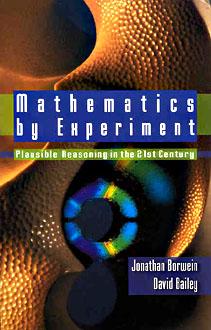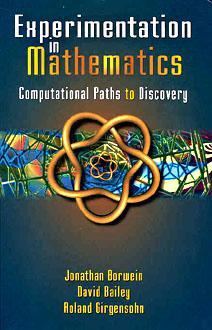How large a role will computer computations play in the mathematics of
tomorrow? The books under review are about many things, but it is clear
that the authors are focused on this question. Their answer: very large.
Their attitude: we should embrace this change.
I agree on both points. Do you? In this review, I'll try to convince you.
Naturally I'll quote from both the first book [BB] and
the second book [BBG]. These two books are clearly
influenced by two papers written by the founding editors of the journal
Experimental Mathematics, [ELL] in 1991 and [EL] in 1995; so I'll quote from them too. Also I'll quote
from a 2002 report [Rep] to the NSF written by 22
computationally-inclined research mathematicians.
[BB], [BBG], [ELL],
and [EL] all have some form of "Experimental Mathematics"
in their titles, and this may appear to some as an oxymoron. Let's agree
that an "experiment" in mathematics means a calculation designed to find or
test a conjecture. So it's something all of us do to at least some extent.
Experiments from long ago. Since we are making predictions about
the future, we should start with a look at the past. [BB] and [Rep] each refer to the same
well-known example, so let's look at this "canonical example."
Gauss writes that as a teenager in the early 1790s he experimentally found
"the density of primes around t is 1/log t, so that the number of primes up
to a given bound x is approximately the integral from 2 to x of dt/log t."
Surely a startling conjecture, but the young Gauss kept it to himself. The
corresponding prime number theorem wasn't proved until 1896.
In the late 1850s, Riemann investigated the error of the integral
approximation and found out it was tied up with the location of the
non-real zeros of the zeta function. He conjectured that all real parts of
these zeta zeroes are 1/2. How did he arrive at this conjecture? One
ingredient was that he computed the first several zeros to several decimal
places, a fact completely buried from public view until Siegel unearthed it
in 1929. Of course, this Riemann hypothesis is still not proved.
What can we learn from this two-part canonical example? We see in each
part that experimental work played an important role. We are reminded that
conjecture can sometimes outrun proof even by centuries. Also we see very
clear illustrations of experimental work being hidden, an aspect of our
community's culture which is elegantly decried as pervasive and
dysfunctional in [ELL] and [EL].
Recent experiments. Since we are making predictions about the
future, we should take a real close look at the present. [EL] says "It is probably the case that most significant
advances in mathematics have arisen from experimentation with examples."
Section 1.1 of [Rep] lists a number of such experiments.
Another example, unusual because the experimental work was prominently
published, concerns "Monstrous Moonshine." This was a title of a 1979
paper by John Conway and Simon Norton reporting on numerical agreement
between coefficients of modular functions and characters of the Monster
group, itself with origin the humble observation that the modular function
coefficient 196884 almost agrees with the Monster character degree 196883.
The agreement has since been explained by the Fields medal work of Richard
Borcherds.
[EL] also says "theory and experiment feed on each
other." Again, one does not have to look far for instances. The entire
history of fractals provides a popularly known instance. Theoretical work
of Fatou and Julia in the 1920s seemed to have little consequence for
decades. But as soon as Julia sets became visible via computers in the
1980s, their work was revived. Many further theoretical results were
obtained, most inspired by careful inspection of computer generated
examples.
A more detailed view of experimental mathematics. So far we have
taken "Experimental Mathematics" to mean the conjectural component of the
traditional research process. The two books [BB] and [BBG] communicate a more refined understanding. They do
this without comprehensively surveying the field. In fact, as they state
in each preface, they mostly stay away from "highly abstract" and "esoteric
mathematics." Rather they focus on aspects of analysis and number theory
which are familiar to most mathematicians.
A major focus of both books is a specific experimental technique, inverse
symbolic computation. Suppose one has a real number c given for
example by an integral or an infinite series. One would like to express
c if possible in terms of known constants, such as algebraic
numbers, π, e, special values of zeta functions, etc. The technique is to
compute c numerically to high precision, say 100 significant
figures. Then, one inputs this approximation into an inverse symbolic
calculator to guess a formula. Then, using the structure of the guessed
formula as a critical clue, one tries to prove the formula. [BB] and [BBG] are replete with
successful instances of this procedure.
One way [BB] and [BBG] may prove to be
influential is that in many ways they have a traditionalist tone.
Experimental techniques are just one more ingredient in the old mix,
sometimes just enough extra to remove roadblocks to progress. A leading
example, touched upon in both books, is the recent progress in multizeta
functions and their applications to quantum field theory.
The experimental approach is capable of breathing new life into
unfashionable traditional areas. For example, computing quantities to
extremely high precision has had for some of us a rather pointless feel.
But now, seeing as high precision is needed for the input to inverse
symbolic calculators, things are different!
A characteristic feature of experimental mathematics is that practitioners
are often awash in a sea of data, out of which they have extracted various
conjectures. Often evidence for a conjecture seems quite substantial. The
traditionalist leanings of the authors are seen here too, as they offer
several cautionary examples of "high precision fraud."
In short, computers can be harnessed to make research into mathematics more
efficient. The main prediction for the future is that this will indeed
happen, and accordingly our conception of mathematics will shift somewhat.
An enlarged vision of mathematics. The last chapter of [BB] begins with a stirring paragraph leading up to "Like it
or not, the world of the mathematician is becoming experimentalized." Why
should we like it? Part of my personal answer is that the computational
approach gives one an enlarged vision of mathematics. In particular,
examples and well-supported conjectures are valued more.
A narrow vision of mathematics is that it is a list of its theorems,
together with a proof or perhaps several for each. Moreover, for a
mathematical statement to be respected as a theorem, it needs to be not
only established as true, but also to satisfy certain unspoken criteria.
Any statement just about the primes less than 1015 say, would be
dismissed in this vision as "just an observation." A statement about all
primes would get closer inspection as a candidate for theoremhood.
The enlarged vision of mathematics that I like says that mathematical
reality is complicated and our job is to expose it. We cannot expect to
fully capture it in short theorems. The colored ring on the cover of [BB], drawn larger and more clearly as Plate VII of [BBG], provides a convenient example. It indicates where
certain polynomials have their roots, with color indicating a root density.
This picture to me is the reality. Theorems about this situation have a
certain humble aspect: they capture only some of the computationally
evident reality.
There are other, non-visual, parts of mathematical reality that stand out
enough to be worthy of careful study. Consider again the Conway-Norton data
tables. The information presented cannot be condensed into a pithy
paragraph to be italicized. Computationalists view this information as
valuable in its own right, not only as a step towards a traditional
theorem. After all, the information involved has the same immutable
quality we admire of theorems. In this vein, [Rep] talks
about the value of online databases as worthy output of mathematical labor.
A more accessible mathematics. A second and closely related reason
we should embrace the computerization of pure mathematics is that it will
render pure mathematics much more accessible to non-mathematicians. At
present we are something of an alien culture to our students and our
scientific colleagues, not to mention the general public. Students enter
our freshman courses with a twelve-year running start in mathematics, and
still often run into difficulties. Tellingly, these very same students may
sometimes do fine in statistics or computer science courses.
[BB] writes in its preface that the experimental approach
helps "to make mathematics tangible, lively, and fun for both the
professional researcher and the novice." While researchers have individual
styles, in my experience all students profit from computer explorations.
Conclusion. The back cover to the second book says that the two
books are "testaments to a paradigm shift in the making." My feeling is
that the incorporation of computers into mathematical research constitutes
an enormous and very positive change, although not quite a paradigm
shift. I encourage you to look through both books and form your own
opinion.
Publication Data:
[BB]
Mathematics
by Experiment: Plausible Reasoning in the 21st century,
by Jonathan Borwein and David Bailey.
A K Peters, 2003.
Hardcover, 288pp, $45.00. ISBN 1568812116.
[BBG]
Experimentation
in Mathematics: Computational Paths to Discovery
by Jonathan Borwein, David Bailey, and Roland Girgensohn.
A K Peters, 2004.
Hardcover, 300pp, $49.00. ISBN 1568811365.
David Bailey maintains an extensive
website
related to the two books. Included are many pages of excerpts from the
two books and many links.
[ELL]
Experimental
Mathematics: Statement of Philosophy and Publishing Criteria , by
David Epstein, Sylvio Levy, and Rafael de la Llave. At the homepage of
the journal
Experimental Mathematics.
[EL]
Experimentation and Proof in Mathematics. David Epstein and
Sylvio Levy. Notices of the
American Mathematical Society , June/July 1995, 670-674.
[Rep]
Computational
Opportunities in Algebra, Number Theory, and Combinatorics,
22 authors, 2002.
David Roberts
is associate professor of mathematics at the University of
Minnesota, Morris.
Posted January 28, 2005
Read This! is the MAA
Online book review column. Contributions are welcome; contact the
editor if you'd like to be one of our reviewers. Books for review should be
sent to the editor: Fernando Gouvêa, Dept. of Mathematics, Colby
College, Waterville, ME 04901. Publishers, please check our
reviews information page.
MAA Online is edited by Fernando Q. Gouvêa
(fqgouvea@colby.edu).
Last modified: Tue Feb 08 12:49:43 Eastern Standard Time 2005

